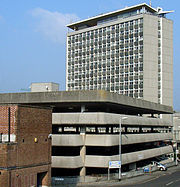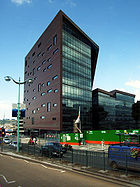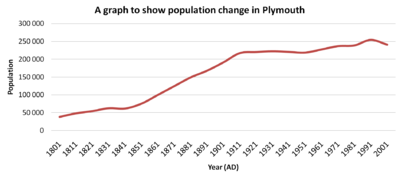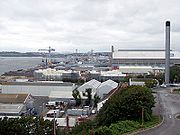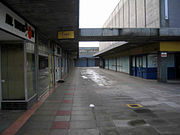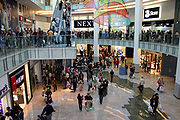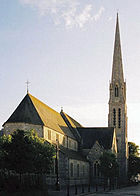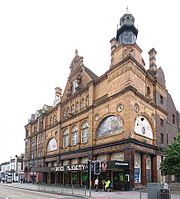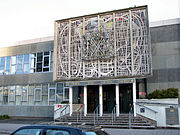
Plymouth
About this schools Wikipedia selection
This wikipedia selection has been chosen by volunteers helping SOS Children from Wikipedia for this Wikipedia Selection for schools. SOS mothers each look after a a family of sponsored children.
| Plymouth | |||
|---|---|---|---|
| — City — | |||
| City of Plymouth | |||
| Plymouth Hoe viewed from the Waterfront | |||
|
|||
| Nickname(s): Spirit of Discovery | |||
| Motto: Turris fortissima est nomen Jehova "The name of Jehova is the strongest tower" |
|||
| Plymouth shown within Devon and England | |||
| Coordinates: 50°22′17.03″N 4°08′32.75″W Coordinates: 50°22′17.03″N 4°08′32.75″W | |||
| Sovereign state | United Kingdom | ||
| Constituent country | England | ||
| Region | South West England | ||
| Ceremonial county | Devon | ||
| City status | 1928 | ||
| Unitary Authority | 1998 | ||
| Government | |||
| • Type | City Council | ||
| • Administration | Conservative | ||
| • Lord Mayor | Mary Aspinall | ||
| • HQ | Civic Centre Precinct | ||
| • Wards | 20 | ||
| • UK Parliament | Moor View Sutton and Devonport South West Devon |
||
| Area | |||
| • Total | 30.61 sq mi (79.29 km2) | ||
| Highest elevation | 509 ft (155 m) | ||
| Lowest elevation | 0 ft (0 m) | ||
| Population (2009 est.) | |||
| • Total | 256,700 | ||
| • Density | 8,261/sq mi (3,188/km2) | ||
| • Demonyms | Plymothian (formal) Janner (informal) |
||
| • Ethnicity (2001) |
98.35% White
|
||
| Population ranked 50/326) | |||
| Time zone | GMT ( UTC0) | ||
| • Summer ( DST) | BST ( UTC+1) | ||
| Postcode district | PL1 — 9 | ||
| Website | www.plymouth.gov.uk | ||
Plymouth ( / ˈ p l ɪ m ə θ /) is a city and unitary authority area on the coast of Devon, England, about 190 miles (310 km) south-west of London. It is built between the mouths of the rivers Plym to the east and Tamar to the west, where they join Plymouth Sound. Since 1967 the City of Plymouth has included the suburbs of Plympton and Plymstock, which are on the east side of the River Plym.
Plymouth's history goes back to the Bronze Age, when its first settlement grew at Mount Batten. This settlement continued to grow as a trading post for the Roman Empire, until the more prosperous village of Sutton, the current Plymouth, surpassed it. In 1620 the Pilgrim Fathers left Plymouth for the New World and established Plymouth Colony – the second English settlement in what is now the United States of America. During the English Civil War the town was held by the Parliamentarians and was besieged between 1642 and 1646.
Throughout the Industrial Revolution Plymouth grew as a major shipping port, handling imports and passengers from the Americas, while the neighbouring town of Devonport grew as an important Royal Naval shipbuilding and dockyard town. The county boroughs of Plymouth and Devonport, and the urban district of East Stonehouse were merged in 1914 to form the single county borough of Plymouth – collectively referred to as The Three Towns. The city's naval importance later led to its targeting and partial destruction during World War II, an act known as the Plymouth Blitz. After the war the city centre was completely rebuilt.
Today the city is home to over 250,000 people, making it the 15th most populous city in England. It is governed locally by Plymouth City Council and is represented nationally by three MPs. Plymouth's economy is still strongly influenced by shipbuilding, but has become a more service-based economy since the 1990s. It has the 9th largest university in the United Kingdom by number of students, the University of Plymouth, and the largest operational naval base in Western Europe – HMNB Devonport. Plymouth has ferry links to France and Spain and an airport with European services.
History
Early history
Upper Palaeolithic deposits, including bones of Homo sapiens, have been found in local caves, and artifacts dating from the Bronze Age to the Middle Iron Age have been found at Mount Batten showing that it was one of the main trading ports of the country at that time. The settlement of Plympton, further up the River Plym than the current Plymouth, was also an early trading port, but the river silted up in the early 11th century and forced the mariners and merchants to settle at the current day Barbican near the river mouth.
At the time this village was called Sutton, meaning south town in Old English. The name Plymouth, meaning "mouth of the River Plym" – the river name being a back-formation from Plympton ("Plum-tree town"), was first mentioned in a Pipe Roll of 1211.
Early defence and Renaissance
During the Hundred Years' War a French attack (1340) burned a manor house and took some prisoners, but failed to get into the town. In 1403 the town was burned by Breton raiders. A series of fortifications were built in the Tudor and Elizabethan eras, which include the four round towers featured on the city coat of arms; the remains of two of these can still be found at Mount Batten and at Sutton Pool below the Royal Citadel.
During the 16th century locally produced wool was the major export commodity. Plymouth was the home port for successful maritime traders, among them Sir John Hawkins, who led England's first foray into the Atlantic slave trade, as well as Sir Francis Drake. According to legend, Drake insisted on completing his game of bowls on the Hoe before engaging the Spanish Armada in 1588. In 1620 the Pilgrim Fathers set sail for the New World from Plymouth, establishing Plymouth Colony – the second English colony in what is now the United States of America.
During the English Civil War Plymouth sided with the Parliamentarians and was besieged for almost four years by the Royalists. The last major attack by the Royalist was by Sir Richard Grenville leading thousands of soldiers towards Plymouth, but they were defeated by the Plymothians. The civil war ended as a Parliamentary win, but monarchy was restored by King Charles II in 1660, who imprisoned many of the Parliamentary heroes on Drake's Island. Construction of the Royal Citadel began in 1665, after the Restoration; it was armed with cannon facing both out to sea and into the town, rumoured to be a reminder to residents not to oppose the Crown.
Throughout the 17th century Plymouth had gradually lost its pre-eminence as a trading port. By the mid-17th century commodities manufactured elsewhere in England cost too much to transport to Plymouth and the city had no means of processing sugar or tobacco imports, although it played a relatively small part in the Atlantic slave trade during the early 18th century. In 1690 the first dockyard, HMNB Devonport, opened on the banks of the Tamar and further docks were built in 1727, 1762 and 1793. In the 18th century new houses were built near the dock, called Plymouth Dock at the time, and a new town grew up. In 1712 there were 318 men employed and by 1733 it had grown to a population of 3,000 people.
Prior to the latter half of the 18th century grain, timber and then coal were Plymouth's greatest imports. During this time the real source of wealth was from the neighbouring town of Devonport – the major employer in the entire region was the dockyard. The Three Towns conurbation of Plymouth, Stonehouse and Devonport enjoyed some prosperity during the late 18th and early 19th century and were enriched by a series of neo-classical urban developments designed by London architect John Foulston. Foulston was important for the town and was responsible for several grand public buildings, many now destroyed, including the Athenaeum, the Theatre Royal and Royal Hotel, and much of Union Street.
The mile-long Breakwater in Plymouth Sound was designed by John Rennie and work started in 1812; numerous technical difficulties and repeated storm damage meant that it was not completed until 1841, twenty years after Rennie's death. In the 1860s, a ring of Palmerston forts was constructed around the outskirts of Devonport, to protect the dockyard from attack from any direction. Some of the greatest imports to Plymouth from the Americas and Europe during the latter half of the 19th century included maize, wheat, barley, sugar cane, guano, sodium nitrate and phosphate. Aside from the dockyard in Devonport, industries in Plymouth such as the gasworks, the railways and tramways and a number of small chemical works had begun to develop in the 19th century, continuing into the 20th century.
Twentieth century
During World War I, Plymouth was the port of entry for many troops from around the Empire and also developed as a facility for the manufacture of munitions. Although major units of the Royal Navy moved to the safety of Scapa Flow, Devonport was an important base for escort vessels and repairs. Flying boats operated from Mount Batten.
In World War II, Devonport was the headquarters of Western Approaches Command until 1941 and Sunderland flying boats were operated by the Royal Australian Air Force. It was an important embarkation point for US troops for D-Day. The city was heavily bombed by the Luftwaffe, in a series of 59 raids known as the Plymouth Blitz. Although the dockyards were the principal targets, much of the city centre and over 3,700 houses were completely destroyed and more than 1,000 civilians lost their lives. This was largely due to Plymouth's status as a major port Charles Church was hit by incendiary bombs and partially destroyed in 1941 during the Blitz, but has not been demolished, as it is now an official permanent monument to the bombing of Plymouth during World War II.
The redevelopment of the city was planned by Sir Patrick Abercrombie in 1943 and by 1964 over 20,000 new homes had been built. Most of the shops had been destroyed and those that remained were cleared to enable a zoned reconstruction according to his plan. In 1962 the modernist high rise of the Civic Centre was constructed, an architecturally significant example of mid twentieth century civic slab-and-tower set piece allowed to fall into disrepair by and recently grade II listed to prevent its demolition.
Postwar, Devonport Dockyard was kept busy refitting aircraft carriers such as the Ark Royal. By the time this work ended in the late 1970s the nuclear submarine base was operational. The army had substantially left the city by 1971, with barracks pulled down in the 1960s, however the city has become home to the 42 Commando of the Royal Marines.
Government
Local government history
The first record of the existence of a settlement at Plymouth was in the Domesday Book in 1086 as Sudtone, Saxon for south farm, located at the present day Barbican. In 1254 it gained status as a town and in 1439, became the first town in England to be granted a Charter by Parliament. Between 1439 and 1934, Plymouth had a Mayor. In 1914 the county boroughs of Plymouth and Devonport, and the urban district of East Stonehouse merged to form a single county borough of Plymouth. Collectively they were referred to as " The Three Towns". Plymouth was granted city status on 18 October 1928. The city's first Lord Mayor was appointed in 1935 and its boundaries further expanded in 1967 to include the town of Plympton and the parish of Plymstock.
The 1971 Local Government White Paper proposed abolishing county boroughs, which would have left Plymouth, a town of 250,000 people, being administered from a council based at the smaller Exeter, on the other side of the county. This led to Plymouth lobbying for the creation of a Tamarside county, to include Plymouth, Torpoint, Saltash, and the rural hinterland. The campaign was not successful, and Plymouth ceased to be a county borough on 1 April 1974 with responsibility for education, social services, highways and libraries transferred to Devon County Council. All powers returned when the city become a unitary authority on 1 April 1998 under recommendations of the Banham Commission.
In the Parliament of the United Kingdom, Plymouth is represented by the three constituencies of Plymouth Moor View, Plymouth Sutton and Devonport and South West Devon and within the European Parliament as South West England. In the 2010 general election, Sutton and Devonport and South West Devon were held by Conservative MPs Oliver Colvile and Gary Streeter, with Moor View held by Labour MP Alison Seabeck.
City Council
The City of Plymouth is divided into 20 wards, 17 of which elect three councillors and the other three electing two councillors, making up a total council of 57. Each year a third of the council is up for election for three consecutive years — there are no elections on the following "fourth" year, which is when County Council elections take place. The total electorate for Plymouth was 183,358 in December 2007. The local election of May 2010 resulted in a political composition of 36 Conservative councillors, 20 Labour and one independent, resulting in a Conservative administration
Plymouth has a Lord Mayor, which is elected each year on the third Friday of May by a group of six people. It is traditional that the position of the Lord Mayor alternates between the Conservative Party and the Labour Party annually and that the Lord Mayor chooses the Deputy Lord Mayor. As of May 2009 and until May 2010 Ken Foster holds the position of Lord Mayor.
The Lord Mayor's official residence is 3 Elliot Terrace, located on the Hoe. Once a home of Waldorf and Nancy Astor, it was given by Lady Astor to the City of Plymouth as an official residence for future Lord Mayors and is also used today for civic hospitality, as lodgings for visiting dignitaries and High Court judges and it is also available to hire for private events. The Civic Centre municipal office building in Armada Way became a listed building in June 2007 because of its quality and period features, but has become the centre of a controversy as the council planned for its demolition estimating that it could cost £40m to refurbish it, resulting in possible job losses.
Plymouth City Council is formally twinned with:
 Brest, France (1963)
Brest, France (1963) Gdynia, Poland (1976)
Gdynia, Poland (1976) Novorossiysk, Russia (1990)
Novorossiysk, Russia (1990) San Sebastián, Spain (1990)
San Sebastián, Spain (1990) Plymouth, Massachusetts, United States (2001)
Plymouth, Massachusetts, United States (2001)
Geography
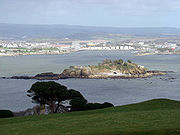
Plymouth lies between the River Plym to the east and the River Tamar to the west; both rivers flow into the natural harbour of Plymouth Sound. Since 1967, the unitary authority of Plymouth has included the, once independent, towns of Plympton and Plymstock which lie along the east of the River Plym. The River Tamar forms the county boundary between Devon and Cornwall and its estuary forms the Hamoaze on which is sited Devonport Dockyard.
The River Plym, which flows off Dartmoor to the north-east, forms a smaller estuary to the east of the city called Cattewater. Plymouth Sound is protected from the sea by the Plymouth Breakwater, in use since 1814. In the Sound is Drake's Island which is seen from Plymouth Hoe, a flat public area on top of limestone cliffs. The Unitary Authority of Plymouth is 30.8 square miles (79.78 km2), but the city of Plymouth, as cited from Plymouth City Council, is 30.61 square miles (79.29 km2). The topography rises from sea level to a height, at Roborough, of about 509 feet (155 m) above Ordnance Datum (AOD).
Geologically, Plymouth has a mixture of limestone, Devonian slate, granite and Middle Devonian limestone. Plymouth Sound, Shores and Cliffs is a Site of Special Scientific Interest, because of its geology. The bulk of the city is built upon Upper Devonian slates and shales and the headlands at the entrance to Plymouth Sound are formed of Lower Devonian slates, which can withstand the power of the sea.
A band of Middle Devonian limestone runs west to east from Cremyll to Plymstock including the Hoe. Local limestone may be seen in numerous buildings, walls and pavements throughout Plymouth. To the north and north east of the city is the granite mass of Dartmoor; the granite was mined and exported via Plymouth. Rocks brought down the Tamar from Dartmoor include ores containing tin, copper, tungsten, lead and other minerals. There is evidence that the middle Devonian limestone belt at the south edge of Plymouth and in Plymstock was quarried at West Hoe, Cattedown and Radford.
On 27 April 1944 Sir Patrick Abercrombie's Plan for Plymouth to rebuild the city was published; it called for the demolition of the few remaining pre-War buildings in the city centre and their replacement with wide, modern boulevards aligned east–west linked by a north–south avenue (Armada Way) connecting the railway station and Plymouth Hoe. Prefabs had started to be built by 1946, and over 1,000 permanent council houses were built each year from 1951–57. By 1964 over 20,000 new homes had been built, more than 13,500 of them permanent council homes and 853 built by the Admiralty. Plymouth is home to 28 parks with an average size of 45,638 square metres (491,240 sq ft). Its largest park is Central Park, with other sizeable green spaces including Victoria Park, Freedom Fields Park, Alexandra Park, Devonport Park and the Hoe.
Climate
| Plymouth | ||||||||||||||||||||||||||||||||||||||||||||||||||||||||||||
|---|---|---|---|---|---|---|---|---|---|---|---|---|---|---|---|---|---|---|---|---|---|---|---|---|---|---|---|---|---|---|---|---|---|---|---|---|---|---|---|---|---|---|---|---|---|---|---|---|---|---|---|---|---|---|---|---|---|---|---|---|
| Climate chart ( explanation) | ||||||||||||||||||||||||||||||||||||||||||||||||||||||||||||
|
||||||||||||||||||||||||||||||||||||||||||||||||||||||||||||
|
||||||||||||||||||||||||||||||||||||||||||||||||||||||||||||
Along with the rest of South West England, Plymouth has a temperate oceanic climate ( Köppen Cfb) which is generally wetter and milder than the rest of England. This means a wide range of exotic plants can be grown. The annual mean temperature is approximately 11 °C (52 °F). Due to the modifying effect of the sea the seasonal range is less than in most other parts of the UK. February is the coldest month with mean minimum temperatures between 3 °C (37 °F) and 4 °C (39 °F). Snow is rare, never usually equating to more that a few flakes, but there have been exclusions, namely the European winter storms of 2009-10 which, in early January, covered Plymouth in at least 1 inch (2.5 cm) of snow, more on higher ground. Another period of notable snow occurred from 17th–19th December 2010 when up to 8 inch (20 cm) of snow fell through the period – though only 2 inches (5 cm) would lie at any one time due to melt. July and August are the warmest months with mean daily maxima over 19 °C (66 °F).
South West England has a favoured location when the Azores High pressure area extends north-eastwards towards the UK, particularly in summer. Coastal areas have average annual sunshine totals over 1,600 hours.
Rainfall tends to be associated with Atlantic depressions or with convection. The Atlantic depressions are more vigorous in autumn and winter and most of the rain which falls in those seasons in the south-west is from this source. Average annual rainfall is around 980 millimetres (39 in). November to March have the highest mean wind speeds, with June to August having the lightest winds. The predominant wind direction is from the south-west.
Education
The University of Plymouth is the 9th largest university in the United Kingdom by total number of students (including the Open University). It has over 30,000 students, almost 3,000 staff and an annual income of around £160 million. It was founded in 1992 from Polytechnic South West (formerly Plymouth Polytechnic) following the Further and Higher Education Act 1992. It has courses in maritime business, marine engineering, marine biology and Earth, ocean and environmental sciences, surf science, shipping and logistics. The university formed a joint venture with the fellow Devonian University of Exeter in 2000, establishing the Peninsula College of Medicine and Dentistry. The college is ranked 8th out of 30 universities in the UK in 2011 for medicine. Its dental school was established in 2006, which also provides free dental care in an attempt to improve access to dental care in the South West.
The city is also home to three large colleges. The University College Plymouth St Mark & St John (known as "Marjon"), which specialises in teacher training, offers training across the country and abroad. The City College Plymouth provides courses from the most basic to Foundation degrees for approximately 26,000 students. Plymouth College of Art offers a selection of courses including media. It was started 153 years ago and is now one of only four independent colleges of art and design in the UK. Plymouth also has 71 state primary phase schools, 13 state secondary schools, eight special schools and three selective state grammar schools, as well as an independent school, Plymouth College.
The city was also home to the Royal Naval Engineering College; opened in 1880 in Keyham, it trained engineering students for five years before they completed the remaining two years of the course at Greenwich. The college closed in 1910, but in 1940 a new college opened at Manadon. This was renamed Dockyard Technical College in 1959 before finally closing in 1994; training was transferred to the University of Southampton.
Plymouth is home to the Plymouth Marine Laboratory, which focuses on global issues of climate change and sustainability. It monitors the effects of ocean acidity on corals and shellfish and reports the results to the UK government. It also cultivates algae that could be used to make biofuels or in the treatment of waste water by using technology such as photo-bioreactors. It works alongside the Boots Group to investigate the use of algae in skin care protects, taking advantage of the chemicals they contain that adapt to protect themselves from the sun.
Demography
In June 2010, the Office for National Statistics estimated that Plymouth's unitary authority area population for mid-2009 was 256,700; 15,980 more people than that of the last census from 2001, which indicated that Plymouth had a population of 240,720. The average household size was 2.3 persons. At the time of the 2001 UK census, the ethnic composition of Plymouth's population was 98.4% White, with the largest minority ethnic group being Chinese at 0.3%. To the right is a graph showing the population change of the city since 1801. The population rose rapidly during the second half of the 19th century, but declined by over 1.6% from 1931 to 1951.
Plymouth's gross value added (a measure of the size of its economy) was 4,105 million GBP in 2007 making up 24% of Devon's GVA. Its GVA per person was £16,377 and compared to the national average of £20,430, was £4,053 lower. Plymouth's unemployment rate was 8.2% in April 2009 – March 2010 which was 1.9 points higher than the South West average and 0.3 points higher than the average for Great Britain (England, Wales and Scotland).
Economy
Because of its coastal location, the economy of Plymouth has traditionally been maritime, in particular the defence sector with over 12,000 people employed and approximately 7,500 in the armed forces. The Plymouth Gin Distillery has been producing Plymouth Gin since 1793, which was exported around the world by the Royal Navy. During the 1930s, it was the most widely distributed gin and has a controlled term of origin. Since the 1980s, employment in the defence sector has decreased substantially and the public sector is now prominent particularly in administration, health, education, medicine and engineering.
Devonport Dockyard is the UK's only naval base that refits nuclear submarines and the Navy estimates that the Dockyard generates about 10% of Plymouth's income. Plymouth has the largest cluster of marine and maritime businesses in the south west with 270 firms operating within the sector. Other substantial employers include the university with 30,000 students and almost 3,000 staff, as well as the Tamar Science Park employing 500 people in 50 companies, which is the fastest growing science park in the United Kingdom.
Plymouth has a post-war shopping area in the city centre with substantial pedestrianisation. At the west end of the zone inside a grade II listed building is the Pannier Market that was completed in 1959 – pannier meaning "basket" from French, so it translates as "basket market". In terms of retail floorspace, Plymouth is ranked in the top five in the South West, and 29th nationally. Plymouth was one of the first ten British cities to trial the new Business Improvement District initiative. The Tinside Pool is situated at the foot of the Hoe and became a grade II listed building in 1998 before being restored to its 1930s look for £3.4 million.
Plymouth 2020
Plymouth Council is currently undertaking a project of urban redevelopment called the "Vision for Plymouth" launched by the architect David Mackay and backed by Plymouth City Council. Its projects range from shopping centres, a cruise terminal, a boulevard and to increase the population to 300,000 and build 33,000 dwellings.
In 2004 the old Drake Circus shopping centre and Charles Cross car park were demolished and replaced by the latest Drake Circus Shopping Centre, which opened in October 2006. It received negative feedback before opening when David Mackay said it was already "ten years out of date". In contrast, the Theatre Royal's production and education centre, TR2, which was built on wasteland at Cattedown, was a runner-up for the RIBA Stirling Prize for Architecture in 2003.
There is a project involving the future relocation of Plymouth City Council's headquarters, the civic centre, to the current location of the Bretonside bus station; it would involve both the bus station and civic centre being demolished and a rebuilt together at the location with the land from the civic centre being sold off. Other suggestions include the demolition of the Plymouth Pavilions entertainment arena to create a canal "boulevard" linking Millbay to the city centre. Millbay is being regenerated with mixed residential, retail and office space alongside the ferry port.
Transport
The A38 dual-carriageway runs from east to west across the north of the city. Heading east, it connects Plymouth to the M5 motorway about 40 miles (64 km) away near Exeter; and heading west it connects Cornwall and Devon via the Tamar Bridge. Regular bus services are provided by Plymouth Citybus, First Group and Target Travel. There are three Park and ride services located at Milehouse, Coypool ( Plympton) and George Junction ( Plymouth City Airport), which are operated by First Group.
A regular international ferry service provided by Brittany Ferries operates from Millbay taking cars and foot passengers directly to France ( Roscoff) and Spain ( Santander) on the three ferries, MV Armorique, MV Bretagne and MV Pont-Aven. There is a passenger ferry between Stonehouse and the Cornish hamlet of Cremyll, which is believed to have operated continuously since 1204. There is also a pedestrian ferry from the Mayflower Steps to Mount Batten, and an alternative to using the Tamar Bridge via the Torpoint Ferry (vehicle and pedestrian) across the River Tamar.
The city's airport is Plymouth City Airport about 4 miles (6.4 km) north of the city centre. The airport is home to the local airline Air Southwest, which operates flights across the British Isles and France. In June 2003 a report by the South West RDA was published looking at the future of aviation in the south-west and the possible closure of airports. It concluded that the best option for the south-west was to close Plymouth City Airport and expand Exeter International Airport and Newquay Cornwall Airport, although it did conclude that this was not the best option for Plymouth.
Plymouth railway station, which opened in 1877, is managed by First Great Western and also sees trains on the CrossCountry and South West Trains networks. Smaller stations are served by local trains on the Tamar Valley Line and Cornish Main Line. First Great Western have come under fire recently, due to widespread rail service cuts across the south-west, which affect Plymouth greatly. Three MPs from the three main political parties in the region have lobbied that the train services are vital to its economy.
Religion
Plymouth has about 150 churches and its Roman Catholic cathedral (1858) is in Stonehouse. The city's oldest church is St Andrew's (Anglican) located at the top of Royal Parade—it is the largest parish church in Devon and has been a site of gathering since AD 800. The city also includes five Baptist churches, a Greek Orthodox church and 13 Roman Catholic churches. In 1831 the first Brethren assembly in England, a movement of conservative non-denominational Evangelical Christians, was established in the city, so that Brethren are often called Plymouth Brethren, although the movement did not begin locally.
Plymouth has the first known reference to Jews in the South West from Sir Francis Drake's voyages in 1577 to 1580, as his log mentioned "Moses the Jew" – a man from Plymouth. The Plymouth Synagogue is a Listed Grade II* building, built in 1762 and is the oldest Ashkenazi Synagogue in the English speaking world. There are also places of worship for Islam, Bahá'í, Buddhism, Unitarian, Chinese beliefs and Humanism.
73.6% of the population described themselves in the last census return as being at least nominally Christian with all other religions represented by less than 0.5% each. The number of people without a religion is above the national average at 18.3%, with 7.1% not stating their religion.
Culture
Built in 1815, Union Street was at the heart of Plymouth's historical culture. It became known as the servicemen's playground, as it was where sailors from the Royal Navy would seek entertainment of all kinds. During the 1930s, there were 30 pubs and it attracted such performers as Charlie Chaplin to the Palace Theatre. It is now the late-night hub of Plymouth's entertainment strip, but has a reputation for trouble at closing hours.
Outdoor events and festivals are held including the annual British Firework Championships in August, which attracts tens of thousands of people across the waterfront. In August 2006 the world record for the most amount of simultaneous fireworks was surpassed, by Roy Lowry of the University of Plymouth, over Plymouth Sound. Since 1992 the Music of the Night has been performed in the Royal Citadel by the 29 Commando Regiment and local performers to raise money for local and military charities.
The city's main theatres are the Theatre Royal (1,315 capacity), its Drum Theatre (200 capacity), and its production and creative learning centre, The TR2. The Plymouth Pavilions has multi uses for the city staging music concerts, basketball matches and stand-up comedy. There are also three cinemas: Reel Cinema at Derrys Cross, Plymouth Arts Centre at Looe Street and a Vue cinema at the Barbican Leisure Park. The Plymouth City Museum and Art Gallery is operated by Plymouth City Council allowing free admission – it has six galleries.
Plymouth is the regional television centre of BBC South West. A team of journalists are headquartered at Plymouth for the ITV South West regional station, after a merger with ITV West forced ITV Westcountry to close on 16 February 2009. The main local newspapers serving Plymouth are The Herald and Western Morning News with BBC Radio Devon, Heart Plymouth, Radio Plymouth and Pirate FM being the main local radio stations.
Sport
Plymouth is home to Plymouth Argyle Football Club, who play in the third tier of English football league known as Football League One. The teams home ground is called Home Park and is located in Central Park. It links itself with the group of English non-conformists that left Plymouth for the New World in 1620: its nickname is "The Pilgrims".
Other sports clubs include Plymouth Albion R.F.C. and the Plymouth Raiders basketball club. Plymouth Albion Rugby Football Club is a rugby union club that was founded in 1875 and are currently competing in the second tier of Professional English Rugby the RFU Championship. They play at The Brickfields. Plymouth Raiders play in the British Basketball League – the top tier of British basketball. They play at the Plymouth Pavilions entertainment arena and were founded in 1983. Plymouth Devils are a speedway team in team in the British National League. Plymouth is home to an American football club: The Plymouth Admirals. Plymouth is also home to Plymouth Marjons Hockey Club, with their 1st XI playing in the National League last season.
Plymouth is an important centre for watersports, especially scuba diving and sailing. The Port of Plymouth Regatta has been held for more than 150 years.
Public services
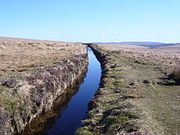
Since 1973 Plymouth has been supplied water by South West Water. Prior to the 1973 take over it was supplied by Plymouth County Borough Corporation. Before the 19th century two leats were built in order to provide drinking water for the town. They carried water from Dartmoor to Plymouth. A watercourse, known as Plymouth or Drake's Leat, was opened on 24 April 1591 to tap the River Meavy. The Devonport Leat was constructed to carry fresh drinking water to the expanding dockyards at Devonport. It was fed by three Dartmoor rivers: The West Dart, Cowsic and Blackabrook. It seems to have been carrying water since 1797, but it was officially completed in 1801. It was originally designed to carry water to Devonport Dockyard, but has since been shortened and now carries water to Burrator Reservoir, which feeds most of the water supply of Plymouth. Burrator Reservoir is located about 5 miles (8.0 km) north of the city and was constructed in 1898 and expanded in 1928.
Plymouth City Council is responsible for waste management throughout the city and South West Water is responsible for sewerage. Plymouth's electricity is supplied from the National Grid and distributed to Plymouth via Western Power Distribution. On the outskirts of Plympton a combined cycle gas-powered station, the Langage Power Station, which started to produce electricity for Plymouth at the end of 2009.
Her Majesty's Courts Service provide a Magistrates' Court and a Combined Crown and County Court in the city. The Plymouth Borough Police, formed in 1836, eventually became part of Devon and Cornwall Constabulary. There are police stations at Charles Cross and Crownhill (the Divisional HQ) and smaller stations at Plympton and Plymstock. The city has one of the Devon and Cornwall Area Crown Prosecution Service Divisional offices. Plymouth has five fire stations located in Camel's Head, Crownhill, Greenbank, Plympton and Plymstock which is part of Devon and Somerset Fire and Rescue Service. The Royal National Lifeboat Institution have an Atlantic 85 class lifeboat and Severn class lifeboat stationed at Millbay Docks.
Plymouth is served by Plymouth Hospitals NHS Trust and the city's NHS hospital is Derriford Hospital 4 miles (6.4 km) north of the city centre and there is also the Royal Eye Infirmary near the city centre. South Western Ambulance Service NHS Trust operates in Plymouth and the rest of the south west; its headquarters are in Exeter.
The mid-19th century burial ground at Ford Park Cemetery was reopened in 2007 by a successful trust and the City council operate two large early 20th century cemeteries at Weston Mill and Efford both with crematoria and chapels. There is also a privately owned cemetery on the outskirts of the city, Drake Memorial Park which does not allow headstones to mark graves, but a brass plaque set into the ground.
Notable people
People from Plymouth are known as Plymothians or less formally as Janners. Its meaning is described as a person from Devon, deriving from Cousin Jan (the Devon form of John), but more particularly in naval circles anyone from the Plymouth area. The Elizabethan navigator, Sir Francis Drake was born in the nearby town of Tavistock and was the mayor of Plymouth. He was the first Englishman to circumnavigate the world and was known by the Spanish as El Draco meaning "The Dragon" after he raided many of their ships. He died of dysentery in 1596 off the coast of Puerto Rico. In 2002 a mission to recover his body and bring it to Plymouth was allowed by the Ministry of Defence. His cousin and contemporary John Hawkins was a Plymouth man. Painter Sir Joshua Reynolds, founder and first president of the Royal Academy was born and educated in nearby Plympton, now part of Plymouth.
Antarctic explorers Robert Falcon Scott and Frank Bickerton both lived in the city. Artists include Beryl Cook whose paintings depict the culture of Plymouth and Robert Lenkiewicz, whose paintings looked at themes such as: vagrancy, sexual behaviour and suicide, lived in the city from the 1960s until his death in 2002. In addition, actors Sir Donald Sinden and Judi Trott. George Passmore of Turner Prize winning duo Gilbert and George were born in the city, as was Labour peer Michael Foot. Notable athletes include swimmer Sharron Davies, diver Tom Daley, dancer Wayne Sleep, and footballer Trevor Francis. Other past residents include composer Ron Goodwin, and journalist Angela Rippon and comedian Dawn French.
Landmarks & tourist attractions
After the English Civil War the Royal Citadel was built in 1666 on the east end of Plymouth Hoe, to defend the port from naval attacks, suppress Plymothian Parliamentary leanings and to train the armed forces. Guided tours are available in the summer months. Further west is Smeaton's Tower, which was built in 1759 as a lighthouse on rocks 14 miles (23 km) off shore, but dismantled and the top two thirds rebuilt on the Hoe in 1877. It is open to the public and has views over the Plymouth Sound and the city from the lantern room. Plymouth has 20 war memorials of which nine are on The Hoe including: Plymouth Naval Memorial, to remember those killed in World Wars I and II, and the National Armada memorial, to commemorate the defeat of the Spanish Armada.
The early port settlement of Plymouth, called "Sutton", approximates to the area now referred to as the Barbican and has 100 listed buildings and the largest concentration of cobbled streets in Britain. The Pilgrim Fathers left for the New World in 1620 near the commemorative Mayflower Steps in Sutton Pool. Also on Sutton Pool is the National Marine Aquarium which displays 400 marine species and includes Britain's deepest aquarium tank.
A mile upstream on the opposite side of the River Plym is the Saltram estate, which has a Jacobean and Georgian mansion.
On the northern outskirts of the city, Crownhill Fort is a well restored example of a " Palmerston's Folly". It is owned by the Landmark Trust and is open to the public.
Plymouth is often used as a base by visitors to Dartmoor, the Tamar Valley and the beaches of south-east Cornwall. Kingsand, Cawsand and Whitsand Bay are popular.
- Images of landmarks








